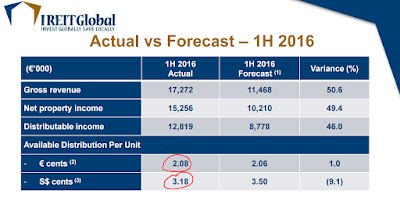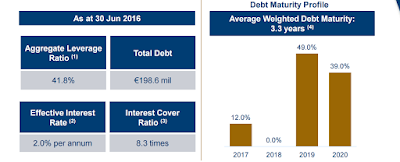Ireit Global announced their Q2 results this evening which I will take a few moments to quickly update their results.
This is a company I’ve taken the decision to average up, with the latest additions coming up only recently this month. It has also taken over to become my largest position currently in the portfolio.
There’s no surprise there with the results as it came in within my expectations.
The revenue and NPI increases double digit year on year due to the acquisitions they made towards the Berlin properties which yielded them an NPI of 7.1%.
The DPU actually came in higher at against their forecast by performing better by 1% but the DPU in Singapore dollar has dropped by 9.1%. The recent weaknesses in the EUR has contributed to this. The sensitivity risk of every 1% drop in the EUR is almost 10% impact there to the DPU.
Nevertheless, it’s something I am aware and comfortable about.
The management has also taken further steps to hedge 100% of the distributional income for FY16 at EUR1: SGD 1.53.
DPU for the first half came in at 3.18 cents, which represents a 8.5% based on current price, still very decent in my opinion given the long QE program the Europe Central Bank is embarking upon.
I owned 72,000 shares currently, which will entitled me to a dividend of $2,290 for the upcoming payout in September.

In terms of their debt maturity and gearing profile, it’s something which as investors I am not too overly concerned about. The company does not have any major refinancing until in 2019 and their coverage ratio stands at a comfortable 8.3 times, higher than most reits you can find out there.
The company does have a heavy gearing at 41.8% on the balance sheet, though this comes at a cheap cost of borrowing at 2%. This means that should they decide to do any acquisitions or AEI, they probably had to reach out to the market for additional funds.
This is not uncommon of reits and it’s just something investors have to be informed about.

The company share price has recently trend upwards and I’d actually like to see them did a placement or rights at this point in time, given that the yield has been compressed, which will make them easier to purchase an acquisition with an accretive yield than before. Even if not, this should make a good chance for them to raise funds in order to have the sufficient funds required for any inorganic growth.
One only has to look at how successful reits like Ascendas did their placement and equity funds to understand what it means to have a rising share price. It’s one of the fundamental for a successful long term reits.
*Vested with 72,000 shares as of writing.


gearing seems pretty high at 41.8%, i guess its likely to do a rights issue within the next 12 months
Hi Felix
Yes i think they are very likely to do a fund raising in the near future, which to me isnt necessarily a bad thing if they can find a solid acquisitions with an attractive npi yield.
HI B ,
Other than gearing , I'm a bit concern about the currency risk,,, as you mentioned ,, 1 % drop in EUR will have almost 10 impact on DPU ,, with very high sensitivity ,,, just curious was it happen to other counters who have asset in other countries like Lippo Mall , Cap Retail China or Fortune etc,, just out of curiosity ,, if this is a " norm " ? Do understand this may not be a fair question as you do not invest in these company ..cheers
Hi STE
I've previously worked in Lmirt before so this is my take on the comparison. For the purpose of this example, im just going to use lmirt but will be applicable to other reits too.
I think its important to see the risk free rate that country is issuing. In Indonesia, savers can get around 4 to 5% on their savings account, so the yield which lmirt is offering (9%) has only a 4% premium. In addition, i think its also important to look at the cost of debt the reits are getting.
For ireit, the Germany bund is yielding negative and the reits cost of debt is cheap at 2%, so the risk premium is much higher. I'm betting on the flow that even if eur continues to weaken, the yield still makes up for the risk or lackin thereof.
I could be wrong on this too of course, but thats my general take 🙂
Hi B,
Yah! Looking at cost of funds vs risk free rate and other factors of analysis. .also, on REIT analysis, one should not just look at dividend yield only. .growth, management's interest alignment with shareholders, cost of funds , creative accounting methods like income support ..should be considered as well.
Cheers! ☺☺
NAV per unit is 42 cents euro which is about 63 cents sgd
at current traded price of 75.5 cents
ireit is trading at a price to book of 1.20
20% premium to book value
doesn't that seems pretty over valued?
similar view +1
vested in this counter too.
usually weary of Reits with >1.0 P/B (not sure if thats a valid concern)
perhaps a good time to divest? not sure.. hmm..
Hi Felix / Bruce / FC
When people look at reits, they tend to think that anything below their book value represents a discount or undervalued. Although that thoughts cannot be said as wrong, I'd chose to think there's a lot more than simply that.
Just think about why the good reits are all trading at a premium and why some reits like sabana, feht and others are trading at a discount. Think why cct is trading at 20% discount to nav but giving investors 5.5% yield while ireit is trading at premium to nav but give investors a yield of 8.5%. If you deepd dive down into the cap rates and how management did financial engineering better for reits trading at premium, you'd understand that owning reits at a premium to nav isny necessarily all bad.
thanks for that insight!
Share price is on an uptrend but gearing ratio seems high which is a risk to take.
Hi SR
Again, like the comments i gave above regarding to nav, simply looking at the high gearing = bad is a simplistic view of looking into reits.
If you'd realize that their cost of debt is so cheap at 2% or what the other reits like mapletree can get their cheap borrowing, you'd then wish for management to maximize shareholders value by gearing as high as they can.
There's a lot more to reits financial engineering than simply premium to nav = high gearing = bad
This comment has been removed by the author.
Hi B, Have you had a chance to look at Viva Industrial Reit? Viva's fundamentals does look better. Would be great if you could share your thoughts, thanks.
Hi Mingjie
Iirc Viva has an income support until 2017 which is currently supporting its high dividend yield. Try to work to remove that and compare across the other industrial reits and see where they stand. I hv not deep dive into them so I'd reserved my comments onto whether it makes a good investment.
Regarding the PB > 1 issue. I have some thoughts.
Please critique my analogy and correct me if I'm wrong. I'm also learning.
Firstly, the forex will affect both BV and dividend yield.
Eg, if euro weaken, our DPU in. SGD is reduced and the BV ratio will also increase.
Eg.
Assume NAV is €1 and you bought the share at SGD1.5 and exchange rate is €1=SGD1.5. In this case, you bought at PB ratio of 1.
Then 1 year later, NAV is still €1, share price is still SGD1.5 but exchange rate becomes €1=SGD1.
So in this case your share price in € becomes €1.5 and your PB ratio becomes 1.5.
My feel is that the high yield compensates the PB>1 issue. Buying above 1, shouldn't affect me unless the fund is bought out at NAV, then I will have a realised loss.
Otherwise the high yield itself should be able to support the price level.
Regards,
FFE
FFR,
If price is trading above NAV, will anyone sell at NAV to buyer?
So that worry will not materialize.
NAV or P/B is one metric to look at but I would think it is ranked below the following:
1) Growth drivers that would potentially increase earnings and hence yield.
2) yield
3) then P/B
P/B >1.2 however will act as a ceiling for capital gain.
Also P/B is not static.
Will increasing rental cash flow, valuation will improve and vice versa.
Some reits have below P/B because their cap rate is quite ridiculous
MIT is one well performing REIT at P/B consistently above 1
Hi FFE and SI
You guys are really good.
I have the same thought as you guys and it is important to understand the 2nd level thinking for reits than the mere basic of what everyone knows about the basic of reits.
Thumbs up!!!
My number 1 would be similar to SI in that I'd look for cAtalyst (earnings driver or rental reversion).
My second priority I'd look for smart financial engineering which will increase shareholders value. This includes doing placement or rights at the right time, rinse and repeat.
Hi SI,
When u say cap rate is crazy, what do you mean? Crazily high or crazily low?
I would assume you mean low right?
N if it's low that we are taking about, then is it low due to low income or high property value?
Regards,
FFE
Low, due to high property value.
Well, there are many factors like years of lease left etc.
But if cap rate is low, the income generated per asset value is low, what really is the big deal with It being below 1 PB and vice versa
Thanks for providing this beneficial information..
cash for real estate notes